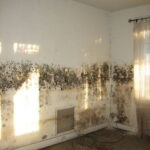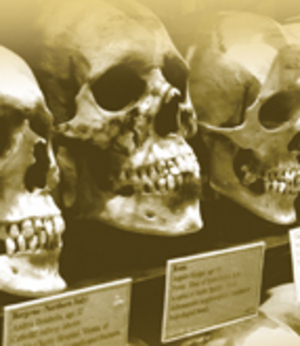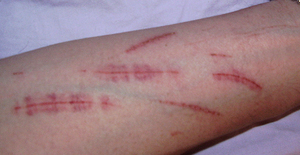Hyrtl Skull Collection Mutter Museum
A wax mold of a woman with a horn growing out of her skull is among the objects on display in this collection. There are several skulls on display showing untreated conditions of the head. The tallest skeleton is is a nine foot colon containing over 40 pounds of fecal matter. On display also is The Soap Lady, whose corpse turned itself into a soapy substance called adipocere better known as grave wax. Many wax models from the early 19th century are on display as are numerous preserved organs and body parts. The museum also hosts a collection of teratological specimens (preserved human fetal specimens) all of which were donated to science; a malignant tumor removed from President Grover Cleveland’s hard palate; the conjoined liver from the famous Siamese twins Chang and Eng Bunker; a piece of tissue removed from the thorax of Abraham Lincoln’s assassin, John Wilkes Booth;, slides of Albert Einstein’s brain and a section of the brain of Charles J. Guiteau who assassinated U.S. President James A. Garfield.
Gretchen Worden
Gretchen Worden (1947-2004) remains perhaps the best known person associated with the Mütter Museum. She joined the museum staff as a curatorial assistant in 1975, became the museum’s curator in 1982 and its director in 1988.
Worden was a frequent guest on the Late Show with David Letterman, “displaying a mischievous glee as she frightened him with human hairballs and wicked-looking Victorian surgical tools, only to disarm him with her antic laugh” and appeared in numerous PBS, BBC and cable television documentaries (including an episode of Errol Morris’ show First Person) as well as NPR’s “Fresh Air with Terry Gross” on the museum’s behalf. She was also instrumental in the creation of numerous Mütter Museum projects, including the popular Mütter Museum calendars and the book, The Mütter Museum: Of the College of Physicians of Philadelphia.
During Worden’s tenure, the visitorship of the museum grew from several hundred visitors each year to, at the time of her death, more than 60,000 tourists annually.
After her death, the Mütter Museum opened a gallery in her memory. In an article written about the gallery’s September 30, 2005 opening, the New York Times described the “Gretchen Worden Room”:
There are jars of preserved human kidneys and livers, and a man’s skull so eaten away by tertiary syphilis that it looks like pounded rock. There are dried severed hands shiny as lacquered wood, showing their veins like leaves; a distended ovary larger than a soccer ball; spines and leg bones so twisted by rickets they’re painful just to see; the skeleton of a dwarf who stood 3 feet 6 inches (1.07 m) small, next to that of a giant who towered seven and a half feet. And “Jim and Joe,” the green-tinted corpse of a two-headed baby, sleeping in a bath of formaldehyde.
Although Worden was known for using humor and shock factor to garner interest in the museum, she nonetheless was respectful of museum’s artifacts. In the foreword of The Mütter Museum: Of the College of Physicians of Philadelphia, she wrote “While these bodies may be ugly, there is a terrifying beauty in the spirits of those forced to endure these afflictions.”
If you are ever in Philadelphia, a visit to the Mutter Museum as well as the Penn Museum is a must-do. Happy traveling!



